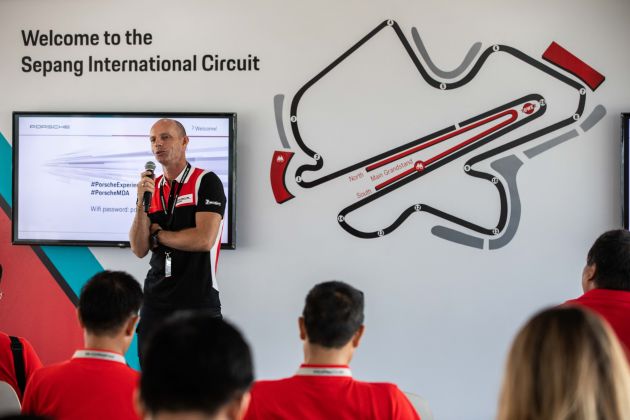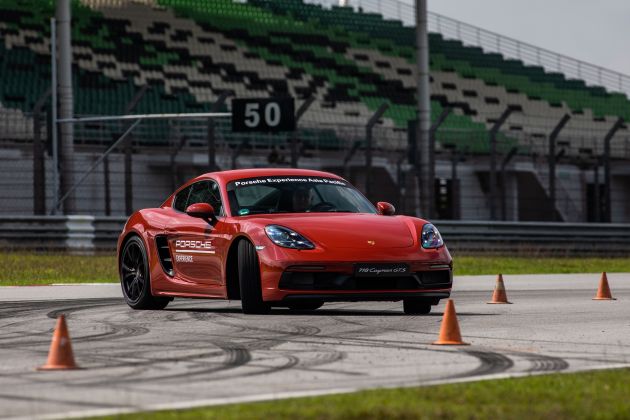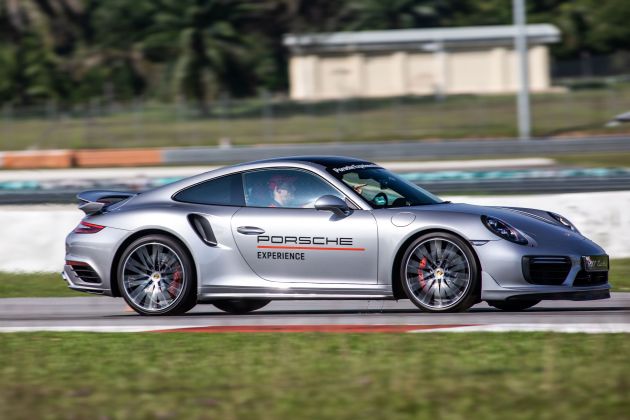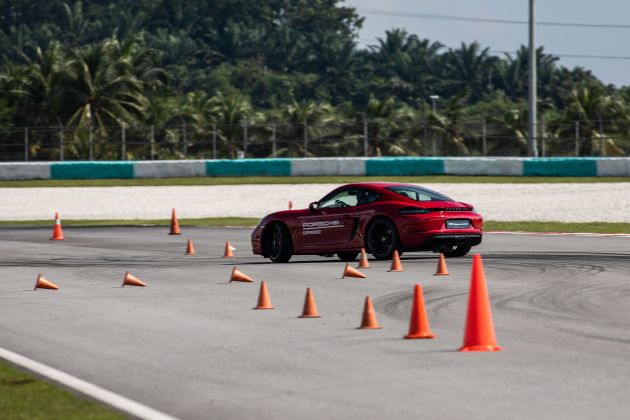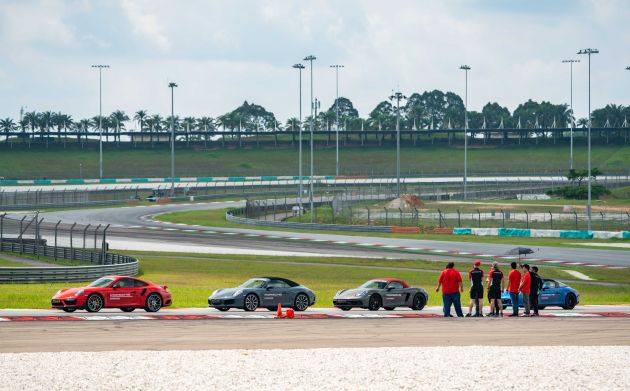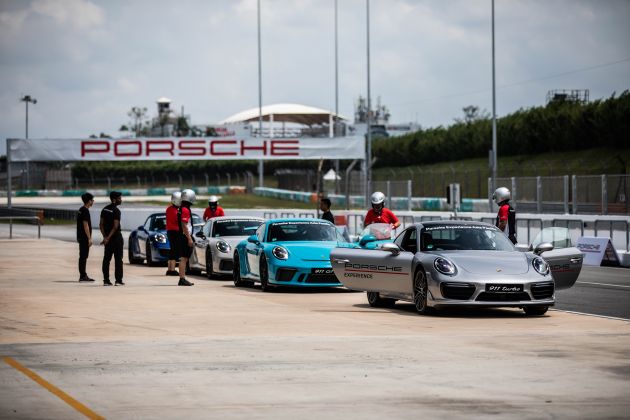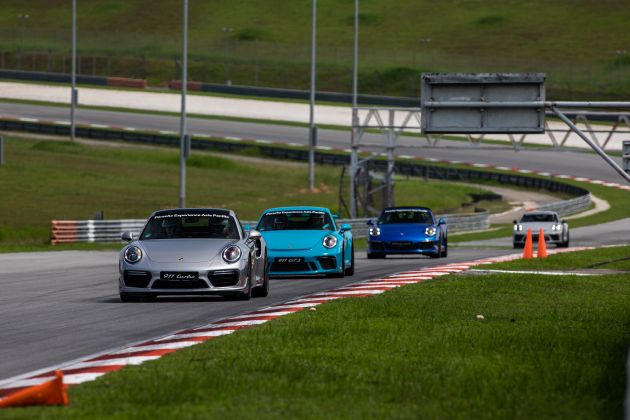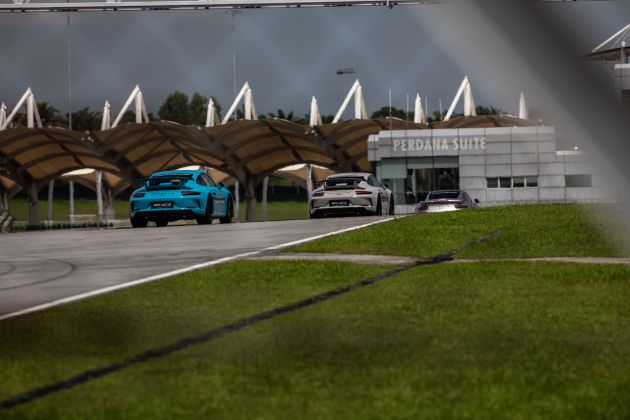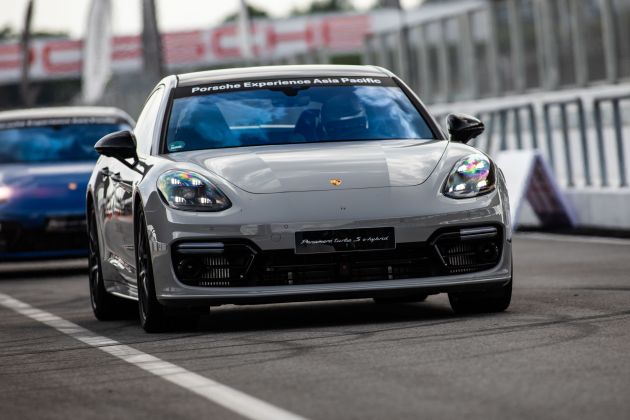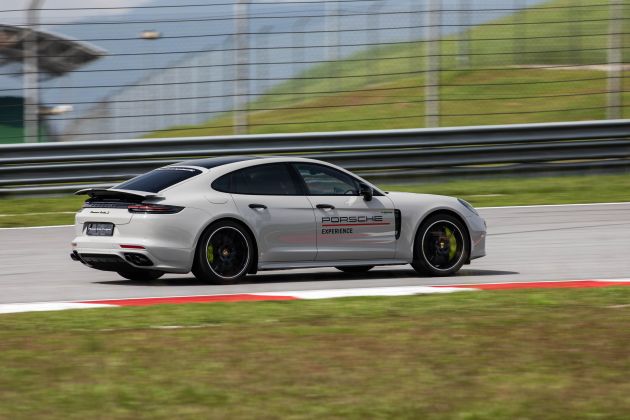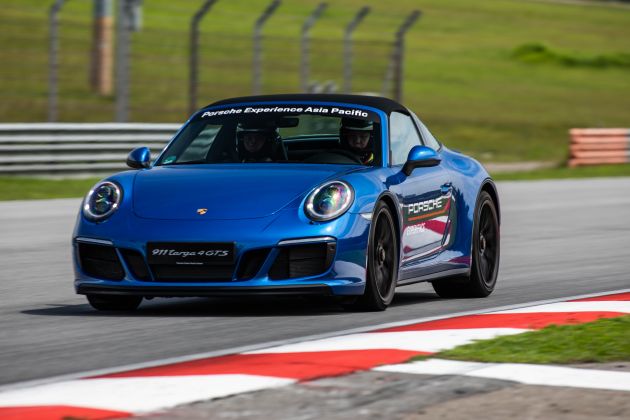First, a diversion, if we may. A motorcycling coach once said, practice is like toilet paper; the more you have, the more you’ll waste. So, then – how best shall one approach practice? Expert instruction is the answer, and coming back to the world of four-wheelers, the Porsche Media Driving Academy is a conduit for said instruction in the four-wheeled realm, aimed at media practitioners.
Though tailored to the journalist, the Porsche Media Driving Academy also represents to an extent what the paying customer will get to experience and learn from in the more conventional capacity of a Porsche owner or enthusiast. This would be the Porsche Experience or the Porsche Sport Driving School (PSDS), which boasts a wide range of classes that is available for the taking.
The range of programmes available for Porsche Experience in the Asia-Pacific market takes place at the Sepang International Circuit, and ranges from Warm-Up, Precision, Performance, Master to GT4 Clubsport MR, in ascending order of advancement. For those who want to just dip their toes into the track experience as a passenger, there is also the Co-Pilot programme.
The Media Driving Academy is divided into Individual, Professional and Elite levels, which represent approximations of the above classes available to the general customer. Our time covered the Elite level, along with the Professional level of training previously.
Our first on-track exercise of the day was an emergency lane change. This was conducted in a 911 Turbo S and a 718 Cayman GTS. Key to mastering the lane change exercise is vision, as cones were laid out to allow minimal variation in lines if one were to successfully navigate the sequence at the prescribed speed. Look where you want to go, so the saying goes.
Following a demonstration run by our instructors, we then took to the wheel for several runs in both the 911 Turbo S and the 718 Cayman GTS. These were conducted with varying levels of stability control assistance – PSM firstly switched on, followed by PSM Sport, which allows great slip angles before intervening, and then finally with the systems fully switched off, where the driver is completely on his own.
The exercise was first sampled by yours truly in the flat-four, mid-engined example, the 718 Cayman GTS. Accelerating to approximately 60 km/h towards the coned course, the mid-engined four-cylinder sports car held a tidy line through the right-left-right sequence, with the PSM stability control keeping the car on course and surprisingly, without feeling like the hand of a warden holding the driver back.
The section was repeated with PSM in Sport, which felt almost similar to having the systems fully switched on. Perhaps the task wasn’t asking much of the Cayman’s chassis. The sequence was taken without brake or throttle input, purely steering. With no untoward incidents save for a few battered cones, we took things up a notch, this time accelerating up to 65 km/h.
With the systems switched on, their intervention at this higher speed was slightly more readily felt, which also made for a more noticeable difference when moving on to the more relaxed nannying of PSM Sport; more speed carries more inertia, in turn placing greater scrutiny upon the tidiness – or lack thereof – in one’s steering input.
Moving on to a very potent version of the Neunelfer, the Turbo S for the same exercise, its badging is just a hint of the sheer physical ferocity that was about to be dished out in acceleration. Certainly, with 580 hp compared to the 365 hp of the Cayman GTS sampled just moments before, the PDK transmission delivers upshifts in such quick succession that the prescribed target speed was very easily overshot. The more pronounced rearward weight bias in the 911 could prove interesting, one imagines.
As it turns out, this lane change exercise revealed a less-than-obvious stability from the 911 Turbo S. Perhaps it is the wider rear rubber, or even the more rearward weight distribution, that made for what felt like a more settled rear end, particularly in the initial turn-in stage. Whereas the Cayman felt more eager to rotate around a pivot seemingly in line with the seat backs of the mid-engined car.
Where the Cayman felt more lively through this sequence, the 911 was more planted, so long as one catches the slide – should it happen – quickly enough in the latter, lest the pendulum of a 3.8 litre biturbo flat-six carries the oversteer beyond saving.
From behind the wheel, in both the 718 Cayman GTS and the 911 Turbo S, PSM Sport felt just about identical to having the system fully switched off, which makes sense – the second, more relaxed programming to the stability control systems essentially means the driver is left to their own devices, to a point.
If the driver manages the weight transfer-induced oversteer quickly enough with corrective steering input, one gets to enjoy being in charge of the mild slip angles, whilst still having the safety net of stability control in place should one go too far beyond the limit of grip.
With the swerving done, it was then onwards to turns Five and Six on the front half of the circuit for another exercise. Parked and awaiting our group was a Panamera Turbo and a 718 Boxster S, and next on the agenda was throttle steering. Before one gets too excited, no, it wasn’t to be about pulling long, smoky drifts.
Turn five at the Sepang International Circuit is a long sweeping left-hander immediately followed by a slightly tighter right-hand turn that is turn six, and for those new to the circuit, the apex to the former is later than first meets the eye. The exercise entails accelerating to speed on the approach into T5, turn in and hold a steady steering angle, and tighten the line as required by easing off the throttle in order to hit both T5 and T6 apices.
As ever, smooth is best with these exercises, and here we had Porsche Carrera Cup Asia driver Will Bamber on site to coach us through the sequence. Bamber’s first demonstration run was conducted how it was supposed to be done – smoothly – and contrasted with the second, deliberately more ragged one.
Patience is key with this section of track, where the trailed throttle into T5 felt like a considerable passage of time, even in something as potent as the 4.0 litre biturbo V8 Panamera Turbo. Of course in the accompanying Boxster S, the same sequence would feel even slower, though the mid-engined two-seater is several hundred kg’s lighter than the Panamera Turbo, and the former’s agility shows, through both the long sweeping T5 and the transition into T6.
Next on the agenda was trail braking, and for this the section, a portion of the South Circuit was used. Starting at the exit of turn 11 in order to build speed towards turn 12, the focus of the session was turn 13 into turn 14, where the trail braking exercise was concentrated. The cars used for this exercise were the Boxster GTS and the 911 Targa 4 GTS.
Charging along the slight descent on the approach into T12, a moderate bit of braking before corner entry is in order. What appears to be a left-right high-speed complex similar to T5 and T6 is actually approached differently – where T5 is taken with a relatively late apex, T12 comes requires an earlier turn-in and the following T13 is a fairly open kink compared to T6.
Here, though, is where the programme participants’ work is cut out. T13 is a continuous arc where the driver will need to get most of their braking done before turning into the circuit’s penultimate T14, which takes a late apex. The tricky bit for this T13-T14 section is waiting long enough before getting on the throttle through T14 for the run down the back straight.
After the lunch break, came the driver fitness part of the programme. Here, our sampling of driver conditioning covered the basics of warming up, stretching, core strength and balance. Should track driving enthusiasts venture further into the hobby, racing is the next logical step, and in that case drivers will have to endure cornering forces for prolonged durations.



Stretching was done mildly to limber up one’s joints, as usually would also be prescribed before the start of any vigorous physical activity. Of particular note was the thumb stretching exercise; in the event of a crash, this aims to give drivers’ thumbs sufficient flexibility to avoid dislocations should they be caught behind the spokes of the steering wheel when and the wheel is jolted violently upon impact.
Core strength exercises came courtesy of the Swiss ball, which would work the core in a couple of different ways. The first was the classic crunch exercise, here conducted with the participant sitting upon the Swiss ball and working the abdominal muscle group.
Why the gym work? Core strength is important for drivers as it will help him or her support one’s own body within the seat without bracing against controls such as the steering wheel, which may compromise the consistency of the driver’s inputs.
The second was a trickier one, as it involved kneeling on said Swiss ball with no support other than from one’s legs; the core muscles would be constantly engaged in an effort to merely stay balanced atop the ball. Most, if not all of us, in that session worked up a sweat.
Following a short break for a quick breather, we took to the tarmac for the last session of the day – full-circuit lapping. Though still an exercise in guided driving, we nonetheless by now have had the day’s exercises committed to memory, leaving more mental capacity with which to savour the cars on offer.
First up in this final session of the day for yours truly was the 911 GT3, boasting 500 hp from its naturally-aspirated 4.0 litre flat-six engine in this facelifted, 991-generation guise. The GT3 was the most fitting of the lot for the racetrack environment, with its deep-set bucket seats and free-breathing engine with a 9,000 rpm limiter.
Its steering immediately felt meatier – albeit not with excessive weight – than those of the Cayman, Boxster and 911 Targa examples, bringing with it a welcome added helping of feel, making itself apparent as soon as we tip into the off-cambered Turn 15.
Exiting this corner is the first time we got to really extend the GT3’s legs, and wow – what a powertrain. Making peak power at 8,250 rpm, the GT3’s powerplant gives another 750 rpm before the limiter calls time, and so an approximate eight-and-a-half on the dial seemed like a good place to click in the upshifts.
Perfect for experiencing the range of aural delights the flat-six has to offer, as it turns out – doing so lands the next gear ratio around the 7,000 rpm mark, where the car sings a sort of multi-layered resonance, almost like a chord on an instrument, as it continues to chase the upper registers into a hard-edged unison at the top. Click the next instantaneous upshift courtesy of the excellent seven-speed PDK, and the chorus repeats.
A note on the PDK Sport button beside the gearlever: having this mode switched on didn’t seem to make gearshifts appreciably quicker in either direction, though it did offer a tangible shove-in-the-back upon upshifts. Perhaps like burbly, crackly exhaust overrun sounds from modern direct-injection engines, the dialed-in shove is superfluous and maybe without performance benefit, but enjoyable to have nonetheless.
Along with a second GT3 in our little chase pack, we were also accompanied by a 911 Targa 4 GTS, and so our instructor in the lead 911 Turbo kept some acceleration in reserve so as to not leave the Targa behind on the straights. Short of lifting off the throttle, which would have upset the rhythm of the pack, we elected for earlier upshifts instead, which also gave us the chance to savour even more of the 4.0 litre flat-six’s tonal varieties. Car as musical instrument – who knew?
At least as impressive as the powertrain was the chassis, which the GT3 demonstrated to delicious effect. Deceleration is exemplary not just in strength, but also in feel afforded through the brake pedal. This was particularly handy when attempting to meter out just the right amount of deceleration as we trailed the brakes into Turn 1, with the instructor voicing ‘keep the nose down, keep the nose down’ over the radio, letting us know to maintain purchase over the cars’ front axles.
Rear-engined traction which has been a Neunelfer hallmark demonstrated itself through the Turn 2 hairpin which immediately follows, and together with the very precise throttle, enabled very early application of near-full throttle as we got cosy with the exit kerbing on the approach to Turn 3.
It’s a refrain which carries on throughout the lap of the circuit, where the engine’s thrust is very closely rivalled by the quality of its supporting acts – chassis, ergonomics and feel – with which the driver is inspired to summon a considerable portion, if not all of the GT3’s abilities in sheer confidence.
The endearing qualities of a 911 at its core remains with its effortlessly comforting driver visibility, thanks to a relatively upright windscreen, brought up to date in recent generations with the relative positioning of seat, pedals and steering wheel beyond reproach, to yours truly. For track day fun, the optional bucket seats are brilliant.
There perhaps could not be a greater contrast within Porsche’s current road-going line-up with the juxtaposition of 911 GT3 or GT3 RS than with the Panamera Turbo S E-Hybrid. With 680 hp and 850 Nm of torque at its disposal courtesy of 550 hp/770 Nm biturbo petrol V8 assisted by a 136 hp electric motor, the Panamera Turbo S E-Hybrid wins the output figures contest easily.
However, the sensations imparted to the driver which characterises each of these cars brings to light the contrast – one is a road car that provides the base for many a circuit racer, and the other is a businessperson’s express for the modern day.
Placed in an environment which so clearly favours the previous car sampled, the Panamera Turbo S E-Hybrid struggled on initial, fleeting impressions, though considered in isolation the big four-door PHEV is a very, very capable handler for its size.
Rolling out from the South Paddock, it is a short run to Turn 15, where the driver is swiftly reminded that the Panamera is no two-seater racetrack refugee, and demands more circumspection where weight transfer – including that which is incurred during braking – is concerned.
Best enjoyed with consideration for the fact that the Panamera Turbo S E-Hybrid weighs more than two tonnes, the 680 hp/850 Nm plug-in hybrid asserts itself very well, though it must be reiterated that the racetrack is hardly the most flattering of stages for it.
Compared to the GT3’s racecar-derived powerplant, the electrified biturbo V8 comes across as a massive, unseen muscle in comparison, propelling the big luxury car to great speeds effortlessly with a relative lack of theatre.
The electrified Panamera appears to follow the same brief in terms of chassis feel; it hangs on tenaciously in corners fast and slow without engaging in the delicate sensations of the smaller Porsches. This would be the ideal cross-continent grand tourer, one imagines.
Following the sledgehammer thrust of the Panamera Turbo S E-Hybrid and the racecar theatrics of the 911 GT3, there was a fear that the 911 Targa 4 GTS would feel like a bit of a downer. As it turns out, the sort-of open top 911 was more subdued in terms of an on-circuit experience, but no less satisfying.
Once again as we rolled out towards pit exit, the 911 cockpit by now felt familiar and thoroughly confidence-inspiring, the 918 Spyder-style till and pedals falling to hands and feet effortlessly. A more modest redline courtesy of this car’s 3.0 litre turbocharged heart is the first clue to how the Targa 4 GTS will feel like.
No surprise, perhaps, that the first major squeeze of the GTS’ throttle along the North straight at Sepang brings a concerted shove earlier in the rev range compared to the GT3, though even with the GT3s in our chase pack evidently faster at the top end, the Targa 4 GTS never felt under-endowed for this 5.5 km-long circuit, even with its two long straights.
Compared to the stints in the GT3, we could hear the instructors’ radioed directions more clearly, full-throttle at 7,000 rpm, now that we were in the turbocharged GTS! At the upper half of its rev range, the GTS mill is very, very responsive, and in our session, the Targa 4 GTS could somewhat keep pace with the GT3s through the turns thanks to turbo grunt delivered earlier in the rev range relative to the GT3’s.
The Targa’s delivery of its 450 hp and 550 Nm of torque are likely better showcased on the road, and the turbocharged engine’s less vocal soundtrack may prove less tiresome on long journeys as well, though its chassis proved to be no slouch on track. While in possession of a less talkative helm, the Targa 4 GTS was no less capable at being hustled around the circuit at speed.
It hasn’t escaped the attention of yours truly that time – if not necessarily money, given the marque’s target market – is truly a precious resource, and that this limitation applies to everyone should drive home the point that practice towards the improvement of car control, or indeed, anything, yields the best results when appropriately focused.
What we’ve experienced in a day at the Sepang International Circuit is but a taste of what’s on offer for Porsche customers and enthusiasts, catering for anyone from the complete newbie looking to upskill and gain confidence, to the seasoned expert who want to go even further and perhaps begin a chapter in racing, with numerous stages in between.
Where driver conditioning for vehicle control is concerned, even at an elementary level, programmes such as these are highly recommended.
Source: Read Full Article

